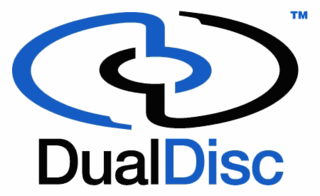
Super Audio CD (SACD) is an optical disc format for audio storage introduced in 1999. It was developed jointly by Sony and Philips Electronics and intended to be the successor to the compact disc (CD) format.
Dolby Digital, originally synonymous with Dolby AC-3, is the name for a family of audio compression technologies developed by Dolby Laboratories. Called Dolby Stereo Digital until 1995, it is lossy compression. The first use of Dolby Digital was to provide digital sound in cinemas from 35 mm film prints. It has since also been used for TV broadcast, radio broadcast via satellite, digital video streaming, DVDs, Blu-ray discs and game consoles.
A DVD player is a device that plays DVDs produced under both the DVD-Video and DVD-Audio technical standards, two different and incompatible standards. Some DVD players will also play audio CDs. DVD players are connected to a television to watch the DVD content, which could be a movie, a recorded TV show, or other content.

DVD-Audio is a digital format for delivering high-fidelity audio content on a DVD. DVD-Audio uses most of the storage on the disc for high-quality audio and is not intended to be a video delivery format.

Direct Stream Digital (DSD) is a trademark used by Sony and Philips for their system for digitally encoding audio signals for the Super Audio CD (SACD).

Meridian Lossless Packing, also known as Packed PCM (PPCM), is a lossless compression technique for PCM audio data developed by Meridian Audio, Ltd. MLP is the standard lossless compression method for DVD-Audio content and typically provides about 1.5:1 compression on most music material. All DVD-Audio players are equipped with MLP decoding, while its use on the discs themselves is at their producers' discretion.
A format war is a competition between similar but mutually incompatible technical standards that compete for the same market, such as for data storage devices and recording formats for electronic media. It is often characterized by political and financial influence on content publishers by the developers of the technologies. Developing companies may be characterized as engaging in a format war if they actively oppose or avoid interoperable open-industry technical standards in favor of their own.

The DualDisc is a type of double-sided optical disc product developed by a group of record companies including MJJ Productions Inc., EMI Music, Universal Music Group, Sony BMG Music Entertainment, Warner Music Group, and 5.1 Entertainment Group and later under the aegis of the Recording Industry Association of America (RIAA). It featured an audio layer intended to be compatible with CD players on one side and a standard DVD layer on the other. In this respect it was similar to, but distinct from, the DVDplus developed in Europe by Dieter Dierks and covered by European patents.
High Definition Compatible Digital (HDCD) is a proprietary audio encode-decode process that claims to provide increased dynamic range over that of standard Compact Disc Digital Audio, while retaining backward compatibility with existing compact disc players.

Versatile Multilayer Disc was a high-capacity red-laser optical disc technology designed by New Medium Enterprises, Inc. VMD was intended to compete with the blue-laser Blu-ray Disc and HD DVD formats and had an initial capacity of up to 30GB per side. At a physical level, VMD is identical to DVD, but with the possibility of using more layers.

DTS, Inc. is an American company. DTS company makes multichannel audio technologies for film and video. Based in Calabasas, California, the company introduced its DTS technology in 1993 as a competitor to Dolby Laboratories, incorporating DTS in the film Jurassic Park (1993). The DTS product is used in surround sound formats for both commercial/theatrical and consumer-grade applications. It was known as The Digital Experience until 1995. DTS licenses its technologies to consumer electronics manufacturers.
Dolby TrueHD is a lossless, multi-channel audio codec developed by Dolby Laboratories for home video, used principally in Blu-ray Disc and compatible hardware. Dolby TrueHD, along with Dolby Digital Plus (E-AC-3) and Dolby AC-4, is one of the intended successors to the Dolby Digital (AC-3) lossy surround format. Dolby TrueHD competes with DTS's DTS-HD Master Audio, another lossless surround sound codec.

DTS-HD Master Audio is a multi-channel, lossless audio codec developed by DTS as an extension of the lossy DTS Coherent Acoustics codec. Rather than being an entirely new coding mechanism, DTS-HD MA encodes an audio master in lossy DTS first, then stores a concurrent stream of supplementary data representing whatever the DTS encoder discarded. This gives DTS-HD MA a lossy "core" able to be played back by devices that cannot decode the more complex lossless audio. DTS-HD MA's primary application is audio storage and playback for Blu-ray Disc media; it competes in this respect with Dolby TrueHD, another lossless surround format.

This article compares the technical specifications of multiple high-definition formats, including HD DVD and Blu-ray Disc; two mutually incompatible, high-definition optical disc formats that, beginning in 2006, attempted to improve upon and eventually replace the DVD standard. The two formats remained in a format war until February 19, 2008, when Toshiba, HD DVD's creator, announced plans to cease development, manufacturing and marketing of HD DVD players and recorders.

Blu-ray is a digital optical disc data storage format designed to supersede the DVD format. It was invented and developed in 2005 and released worldwide on June 20, 2006, capable of storing several hours of high-definition video. The main application of Blu-ray is as a medium for video material such as feature films and for the physical distribution of video games for the PlayStation 3, PlayStation 4, PlayStation 5, Xbox One, and Xbox Series X. The name refers to the blue laser used to read the disc, which allows information to be stored at a greater density than is possible with the longer-wavelength red laser used for DVDs.

HD DVD is an obsolete high-density optical disc format for storing data and playback of high-definition video. Supported principally by Toshiba, HD DVD was envisioned to be the successor to the standard DVD format, but lost to Blu-ray, supported by Sony and others.
.m2ts is a filename extension used for the Blu-ray disc Audio-Video (BDAV) MPEG-2 Transport Stream (M2TS) container file format. It is used for multiplexing audio, video and other streams, such as subtitles. It is based on the MPEG-2 transport stream container. This container format is commonly used for high definition video on Blu-ray Disc and AVCHD.

DVD-Video is a consumer video format used to store digital video on DVDs. DVD-Video was the dominant consumer home video format in Asia, North America, Europe, and Australia in the 2000s until it was supplanted by the high-definition Blu-ray Disc. Discs using the DVD-Video specification require a DVD drive and an MPEG-2 decoder. Commercial DVD movies are encoded using a combination of MPEG-2 compressed video and audio of varying formats. Typically, the data rate for DVD movies ranges from 3 to 9.5 Mbit/s, and the bit rate is usually adaptive. DVD-Video was first available in Japan on November 1, 1996, followed by a release on March 24, 1997 in the United States—to line up with the 69th Academy Awards that same day.
High-resolution audio is a term for audio files with greater than 44.1 kHz sample rate or higher than 16-bit audio bit depth. It commonly refers to 96 or 192 kHz sample rates. However, 44.1 kHz/24-bit, 48 kHz/24-bit and 88.2 kHz/24-bit recordings also exist that are labeled HD Audio.











